The Doctrine of the Separation of Powers-Normative Analysis
VerifiedAdded on 2023/03/31
|8
|1816
|176
AI Summary
This article provides a normative analysis of the doctrine of separation of powers, its origins, and its impact on government structures. It explores the three branches of government and their respective roles, as well as the benefits and challenges of the doctrine. The article concludes by discussing the effectiveness of the doctrine in maintaining a balance of power and controlling government authority.
Contribute Materials
Your contribution can guide someone’s learning journey. Share your
documents today.
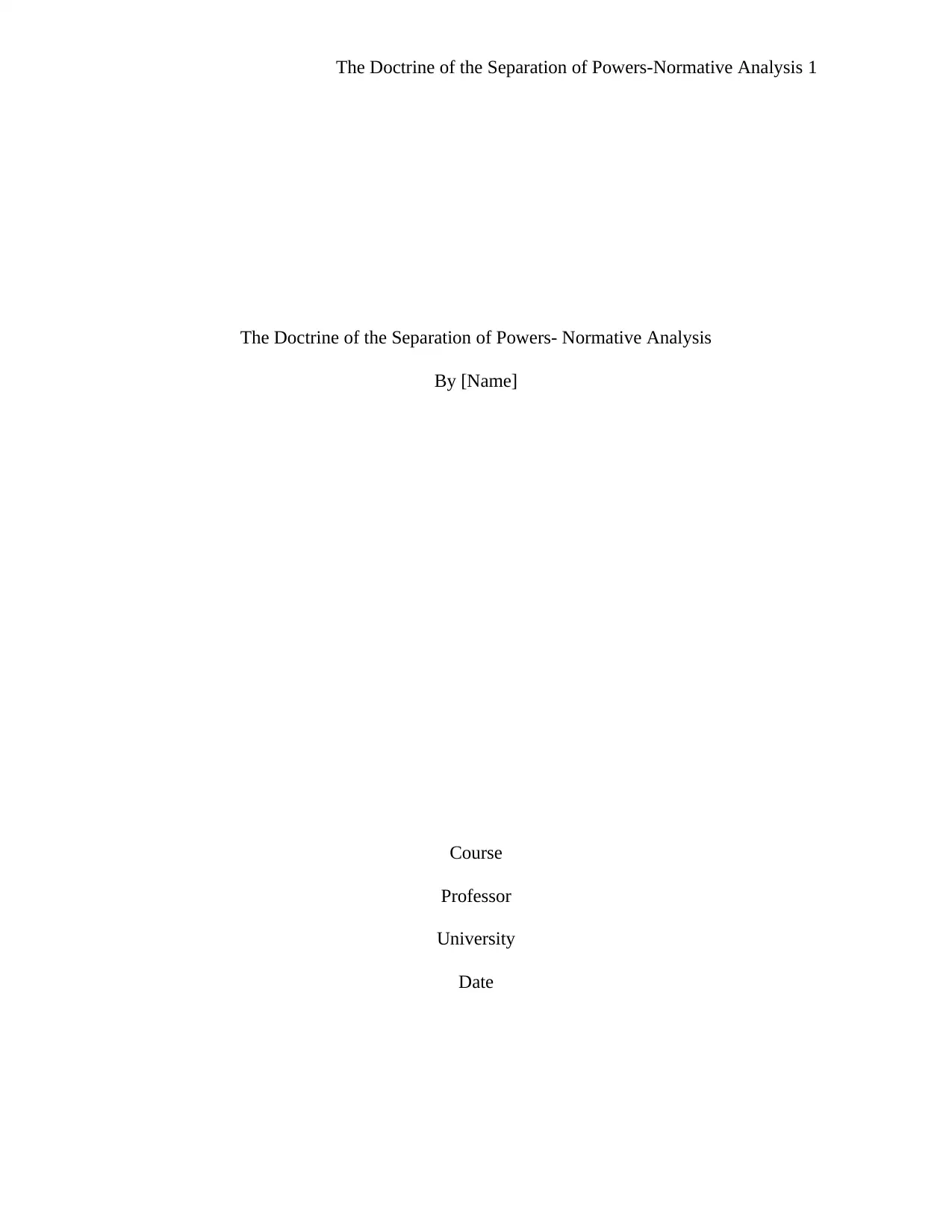
The Doctrine of the Separation of Powers-Normative Analysis 1
The Doctrine of the Separation of Powers- Normative Analysis
By [Name]
Course
Professor
University
Date
The Doctrine of the Separation of Powers- Normative Analysis
By [Name]
Course
Professor
University
Date
Secure Best Marks with AI Grader
Need help grading? Try our AI Grader for instant feedback on your assignments.
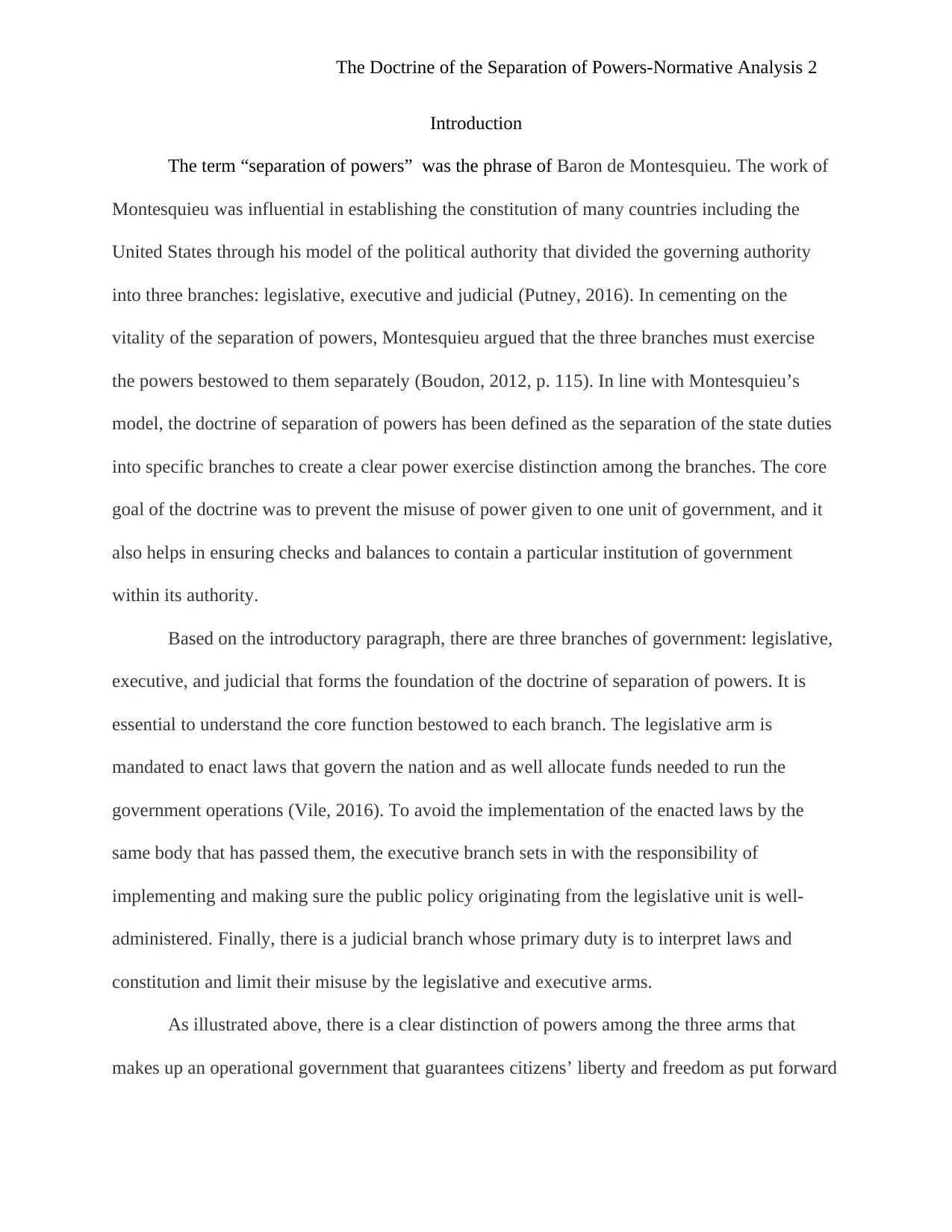
The Doctrine of the Separation of Powers-Normative Analysis 2
Introduction
The term “separation of powers” was the phrase of Baron de Montesquieu. The work of
Montesquieu was influential in establishing the constitution of many countries including the
United States through his model of the political authority that divided the governing authority
into three branches: legislative, executive and judicial (Putney, 2016). In cementing on the
vitality of the separation of powers, Montesquieu argued that the three branches must exercise
the powers bestowed to them separately (Boudon, 2012, p. 115). In line with Montesquieu’s
model, the doctrine of separation of powers has been defined as the separation of the state duties
into specific branches to create a clear power exercise distinction among the branches. The core
goal of the doctrine was to prevent the misuse of power given to one unit of government, and it
also helps in ensuring checks and balances to contain a particular institution of government
within its authority.
Based on the introductory paragraph, there are three branches of government: legislative,
executive, and judicial that forms the foundation of the doctrine of separation of powers. It is
essential to understand the core function bestowed to each branch. The legislative arm is
mandated to enact laws that govern the nation and as well allocate funds needed to run the
government operations (Vile, 2016). To avoid the implementation of the enacted laws by the
same body that has passed them, the executive branch sets in with the responsibility of
implementing and making sure the public policy originating from the legislative unit is well-
administered. Finally, there is a judicial branch whose primary duty is to interpret laws and
constitution and limit their misuse by the legislative and executive arms.
As illustrated above, there is a clear distinction of powers among the three arms that
makes up an operational government that guarantees citizens’ liberty and freedom as put forward
Introduction
The term “separation of powers” was the phrase of Baron de Montesquieu. The work of
Montesquieu was influential in establishing the constitution of many countries including the
United States through his model of the political authority that divided the governing authority
into three branches: legislative, executive and judicial (Putney, 2016). In cementing on the
vitality of the separation of powers, Montesquieu argued that the three branches must exercise
the powers bestowed to them separately (Boudon, 2012, p. 115). In line with Montesquieu’s
model, the doctrine of separation of powers has been defined as the separation of the state duties
into specific branches to create a clear power exercise distinction among the branches. The core
goal of the doctrine was to prevent the misuse of power given to one unit of government, and it
also helps in ensuring checks and balances to contain a particular institution of government
within its authority.
Based on the introductory paragraph, there are three branches of government: legislative,
executive, and judicial that forms the foundation of the doctrine of separation of powers. It is
essential to understand the core function bestowed to each branch. The legislative arm is
mandated to enact laws that govern the nation and as well allocate funds needed to run the
government operations (Vile, 2016). To avoid the implementation of the enacted laws by the
same body that has passed them, the executive branch sets in with the responsibility of
implementing and making sure the public policy originating from the legislative unit is well-
administered. Finally, there is a judicial branch whose primary duty is to interpret laws and
constitution and limit their misuse by the legislative and executive arms.
As illustrated above, there is a clear distinction of powers among the three arms that
makes up an operational government that guarantees citizens’ liberty and freedom as put forward
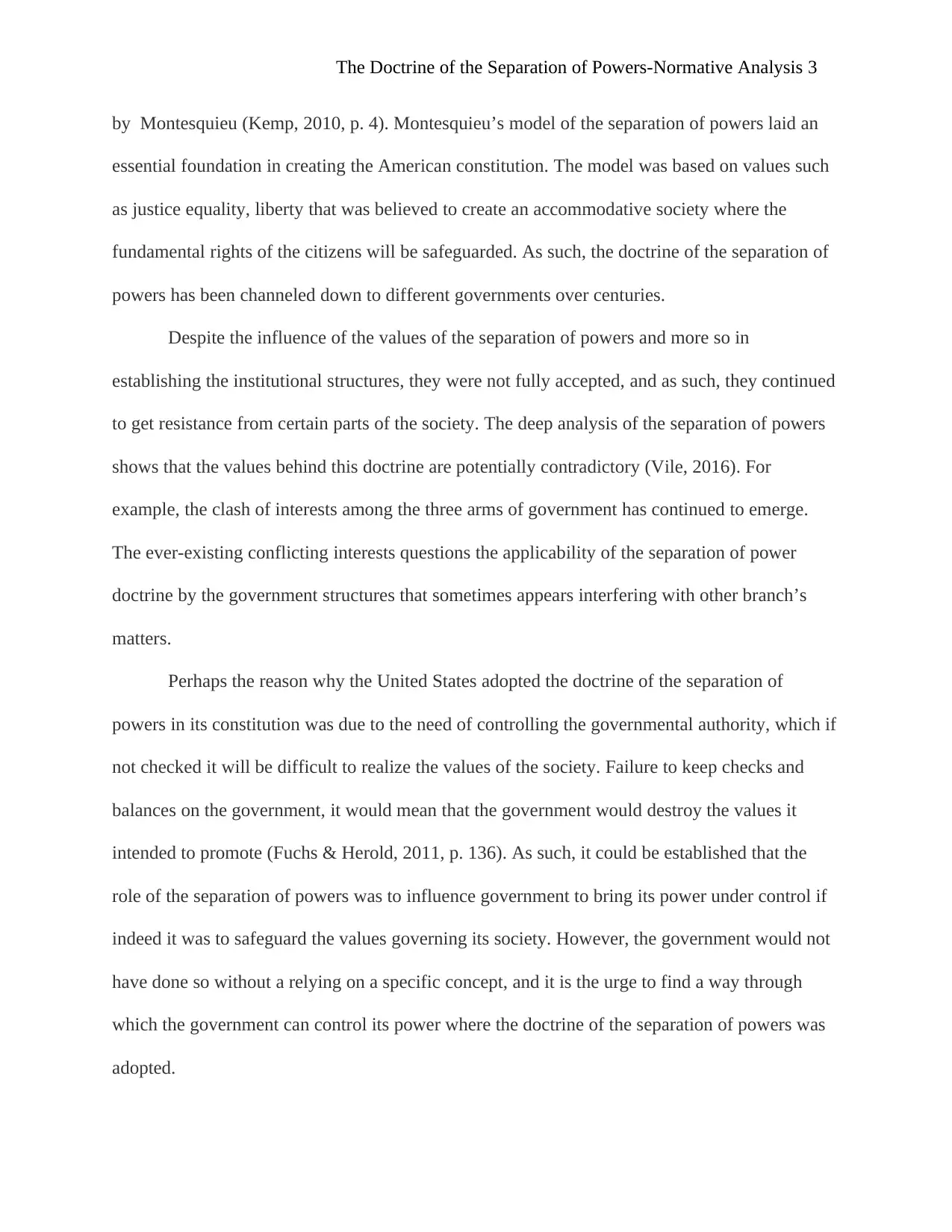
The Doctrine of the Separation of Powers-Normative Analysis 3
by Montesquieu (Kemp, 2010, p. 4). Montesquieu’s model of the separation of powers laid an
essential foundation in creating the American constitution. The model was based on values such
as justice equality, liberty that was believed to create an accommodative society where the
fundamental rights of the citizens will be safeguarded. As such, the doctrine of the separation of
powers has been channeled down to different governments over centuries.
Despite the influence of the values of the separation of powers and more so in
establishing the institutional structures, they were not fully accepted, and as such, they continued
to get resistance from certain parts of the society. The deep analysis of the separation of powers
shows that the values behind this doctrine are potentially contradictory (Vile, 2016). For
example, the clash of interests among the three arms of government has continued to emerge.
The ever-existing conflicting interests questions the applicability of the separation of power
doctrine by the government structures that sometimes appears interfering with other branch’s
matters.
Perhaps the reason why the United States adopted the doctrine of the separation of
powers in its constitution was due to the need of controlling the governmental authority, which if
not checked it will be difficult to realize the values of the society. Failure to keep checks and
balances on the government, it would mean that the government would destroy the values it
intended to promote (Fuchs & Herold, 2011, p. 136). As such, it could be established that the
role of the separation of powers was to influence government to bring its power under control if
indeed it was to safeguard the values governing its society. However, the government would not
have done so without a relying on a specific concept, and it is the urge to find a way through
which the government can control its power where the doctrine of the separation of powers was
adopted.
by Montesquieu (Kemp, 2010, p. 4). Montesquieu’s model of the separation of powers laid an
essential foundation in creating the American constitution. The model was based on values such
as justice equality, liberty that was believed to create an accommodative society where the
fundamental rights of the citizens will be safeguarded. As such, the doctrine of the separation of
powers has been channeled down to different governments over centuries.
Despite the influence of the values of the separation of powers and more so in
establishing the institutional structures, they were not fully accepted, and as such, they continued
to get resistance from certain parts of the society. The deep analysis of the separation of powers
shows that the values behind this doctrine are potentially contradictory (Vile, 2016). For
example, the clash of interests among the three arms of government has continued to emerge.
The ever-existing conflicting interests questions the applicability of the separation of power
doctrine by the government structures that sometimes appears interfering with other branch’s
matters.
Perhaps the reason why the United States adopted the doctrine of the separation of
powers in its constitution was due to the need of controlling the governmental authority, which if
not checked it will be difficult to realize the values of the society. Failure to keep checks and
balances on the government, it would mean that the government would destroy the values it
intended to promote (Fuchs & Herold, 2011, p. 136). As such, it could be established that the
role of the separation of powers was to influence government to bring its power under control if
indeed it was to safeguard the values governing its society. However, the government would not
have done so without a relying on a specific concept, and it is the urge to find a way through
which the government can control its power where the doctrine of the separation of powers was
adopted.

The Doctrine of the Separation of Powers-Normative Analysis 4
As noted earlier, the doctrine of separation of powers was the critical feature in the
United States Constitution, and it has been exhibited in the declaration of independence and
federalist papers. The U.S. constitution observed the doctrine of separation of powers to secure
liberty to the citizens, ensure justice, and ensure tranquility within the nation (The U.S. National
Archives, n.d.). The Declaration of Independence left the option for the Americans to continue
fighting for equality and freedom (National Archives, n.d.). But the inclusivity of the doctrine of
the separation of powers in the America constitution begs the question, “how did it find itself in
the American’s constitution?” The answer to this question lies in the application of the same
doctrine in the ancient world to solve the problem of imbalance in governments. The concept of
the separation of power was transmitted through writings and later found itself in England where
it was further spread to the United States through writings including the work of Baron De
Montesquieu in his book, The Spirit of Laws as presented by (Manning, 2011, p. 1939).
It is debatable whether the separation of powers had a space in the American political
system. The solution to the above debate lies in the notion of the founders of the United States
who believed that people, and particularly men were naturally corrupt (Hamilton, n.d.). The
founding father believed that when men were bestowed with the power, they were likely to
become tyrannical, and as a result, there was a need to find a way of controlling them. However,
they could not have achieved without having a clear mechanism to control the power that rested
with certain individuals and structures of the government. To solve that puzzle the founders gave
out the separation of powers in several areas as including “church state, money and state,
marriage and state, education and state, media and state, people and government, state and
federal and separation of power with three branches in both the state and federal governments”
(Glassman, 2016).
As noted earlier, the doctrine of separation of powers was the critical feature in the
United States Constitution, and it has been exhibited in the declaration of independence and
federalist papers. The U.S. constitution observed the doctrine of separation of powers to secure
liberty to the citizens, ensure justice, and ensure tranquility within the nation (The U.S. National
Archives, n.d.). The Declaration of Independence left the option for the Americans to continue
fighting for equality and freedom (National Archives, n.d.). But the inclusivity of the doctrine of
the separation of powers in the America constitution begs the question, “how did it find itself in
the American’s constitution?” The answer to this question lies in the application of the same
doctrine in the ancient world to solve the problem of imbalance in governments. The concept of
the separation of power was transmitted through writings and later found itself in England where
it was further spread to the United States through writings including the work of Baron De
Montesquieu in his book, The Spirit of Laws as presented by (Manning, 2011, p. 1939).
It is debatable whether the separation of powers had a space in the American political
system. The solution to the above debate lies in the notion of the founders of the United States
who believed that people, and particularly men were naturally corrupt (Hamilton, n.d.). The
founding father believed that when men were bestowed with the power, they were likely to
become tyrannical, and as a result, there was a need to find a way of controlling them. However,
they could not have achieved without having a clear mechanism to control the power that rested
with certain individuals and structures of the government. To solve that puzzle the founders gave
out the separation of powers in several areas as including “church state, money and state,
marriage and state, education and state, media and state, people and government, state and
federal and separation of power with three branches in both the state and federal governments”
(Glassman, 2016).
Secure Best Marks with AI Grader
Need help grading? Try our AI Grader for instant feedback on your assignments.
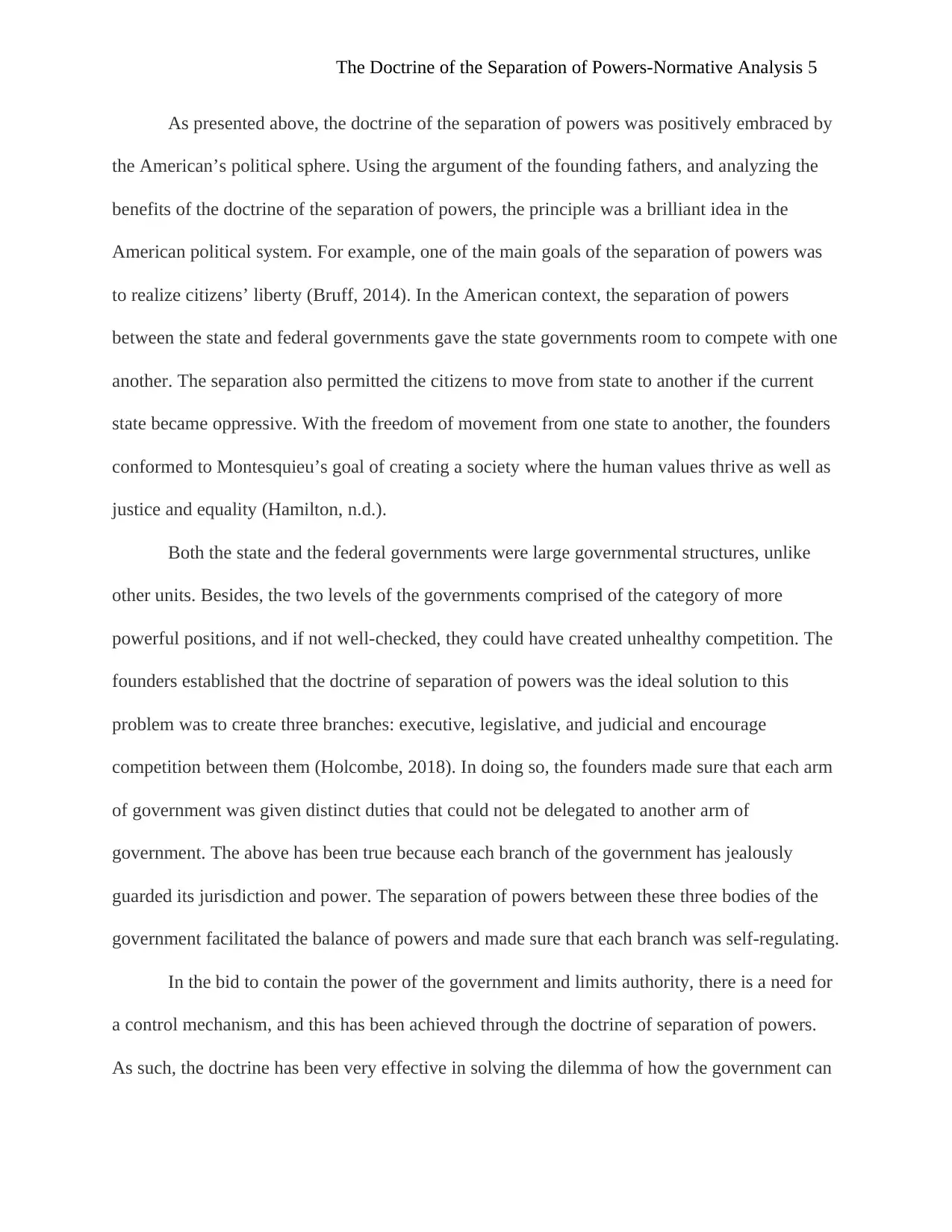
The Doctrine of the Separation of Powers-Normative Analysis 5
As presented above, the doctrine of the separation of powers was positively embraced by
the American’s political sphere. Using the argument of the founding fathers, and analyzing the
benefits of the doctrine of the separation of powers, the principle was a brilliant idea in the
American political system. For example, one of the main goals of the separation of powers was
to realize citizens’ liberty (Bruff, 2014). In the American context, the separation of powers
between the state and federal governments gave the state governments room to compete with one
another. The separation also permitted the citizens to move from state to another if the current
state became oppressive. With the freedom of movement from one state to another, the founders
conformed to Montesquieu’s goal of creating a society where the human values thrive as well as
justice and equality (Hamilton, n.d.).
Both the state and the federal governments were large governmental structures, unlike
other units. Besides, the two levels of the governments comprised of the category of more
powerful positions, and if not well-checked, they could have created unhealthy competition. The
founders established that the doctrine of separation of powers was the ideal solution to this
problem was to create three branches: executive, legislative, and judicial and encourage
competition between them (Holcombe, 2018). In doing so, the founders made sure that each arm
of government was given distinct duties that could not be delegated to another arm of
government. The above has been true because each branch of the government has jealously
guarded its jurisdiction and power. The separation of powers between these three bodies of the
government facilitated the balance of powers and made sure that each branch was self-regulating.
In the bid to contain the power of the government and limits authority, there is a need for
a control mechanism, and this has been achieved through the doctrine of separation of powers.
As such, the doctrine has been very effective in solving the dilemma of how the government can
As presented above, the doctrine of the separation of powers was positively embraced by
the American’s political sphere. Using the argument of the founding fathers, and analyzing the
benefits of the doctrine of the separation of powers, the principle was a brilliant idea in the
American political system. For example, one of the main goals of the separation of powers was
to realize citizens’ liberty (Bruff, 2014). In the American context, the separation of powers
between the state and federal governments gave the state governments room to compete with one
another. The separation also permitted the citizens to move from state to another if the current
state became oppressive. With the freedom of movement from one state to another, the founders
conformed to Montesquieu’s goal of creating a society where the human values thrive as well as
justice and equality (Hamilton, n.d.).
Both the state and the federal governments were large governmental structures, unlike
other units. Besides, the two levels of the governments comprised of the category of more
powerful positions, and if not well-checked, they could have created unhealthy competition. The
founders established that the doctrine of separation of powers was the ideal solution to this
problem was to create three branches: executive, legislative, and judicial and encourage
competition between them (Holcombe, 2018). In doing so, the founders made sure that each arm
of government was given distinct duties that could not be delegated to another arm of
government. The above has been true because each branch of the government has jealously
guarded its jurisdiction and power. The separation of powers between these three bodies of the
government facilitated the balance of powers and made sure that each branch was self-regulating.
In the bid to contain the power of the government and limits authority, there is a need for
a control mechanism, and this has been achieved through the doctrine of separation of powers.
As such, the doctrine has been very effective in solving the dilemma of how the government can
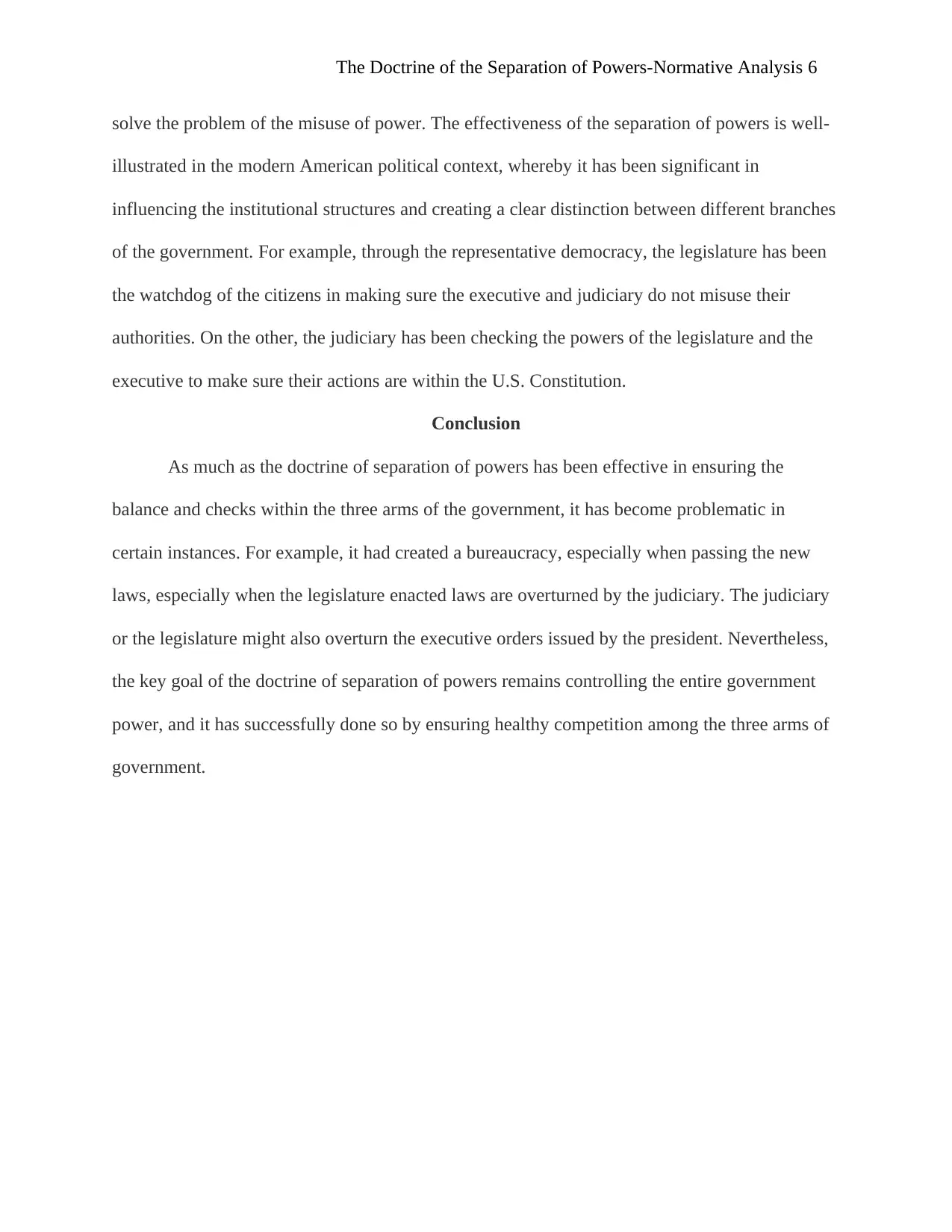
The Doctrine of the Separation of Powers-Normative Analysis 6
solve the problem of the misuse of power. The effectiveness of the separation of powers is well-
illustrated in the modern American political context, whereby it has been significant in
influencing the institutional structures and creating a clear distinction between different branches
of the government. For example, through the representative democracy, the legislature has been
the watchdog of the citizens in making sure the executive and judiciary do not misuse their
authorities. On the other, the judiciary has been checking the powers of the legislature and the
executive to make sure their actions are within the U.S. Constitution.
Conclusion
As much as the doctrine of separation of powers has been effective in ensuring the
balance and checks within the three arms of the government, it has become problematic in
certain instances. For example, it had created a bureaucracy, especially when passing the new
laws, especially when the legislature enacted laws are overturned by the judiciary. The judiciary
or the legislature might also overturn the executive orders issued by the president. Nevertheless,
the key goal of the doctrine of separation of powers remains controlling the entire government
power, and it has successfully done so by ensuring healthy competition among the three arms of
government.
solve the problem of the misuse of power. The effectiveness of the separation of powers is well-
illustrated in the modern American political context, whereby it has been significant in
influencing the institutional structures and creating a clear distinction between different branches
of the government. For example, through the representative democracy, the legislature has been
the watchdog of the citizens in making sure the executive and judiciary do not misuse their
authorities. On the other, the judiciary has been checking the powers of the legislature and the
executive to make sure their actions are within the U.S. Constitution.
Conclusion
As much as the doctrine of separation of powers has been effective in ensuring the
balance and checks within the three arms of the government, it has become problematic in
certain instances. For example, it had created a bureaucracy, especially when passing the new
laws, especially when the legislature enacted laws are overturned by the judiciary. The judiciary
or the legislature might also overturn the executive orders issued by the president. Nevertheless,
the key goal of the doctrine of separation of powers remains controlling the entire government
power, and it has successfully done so by ensuring healthy competition among the three arms of
government.
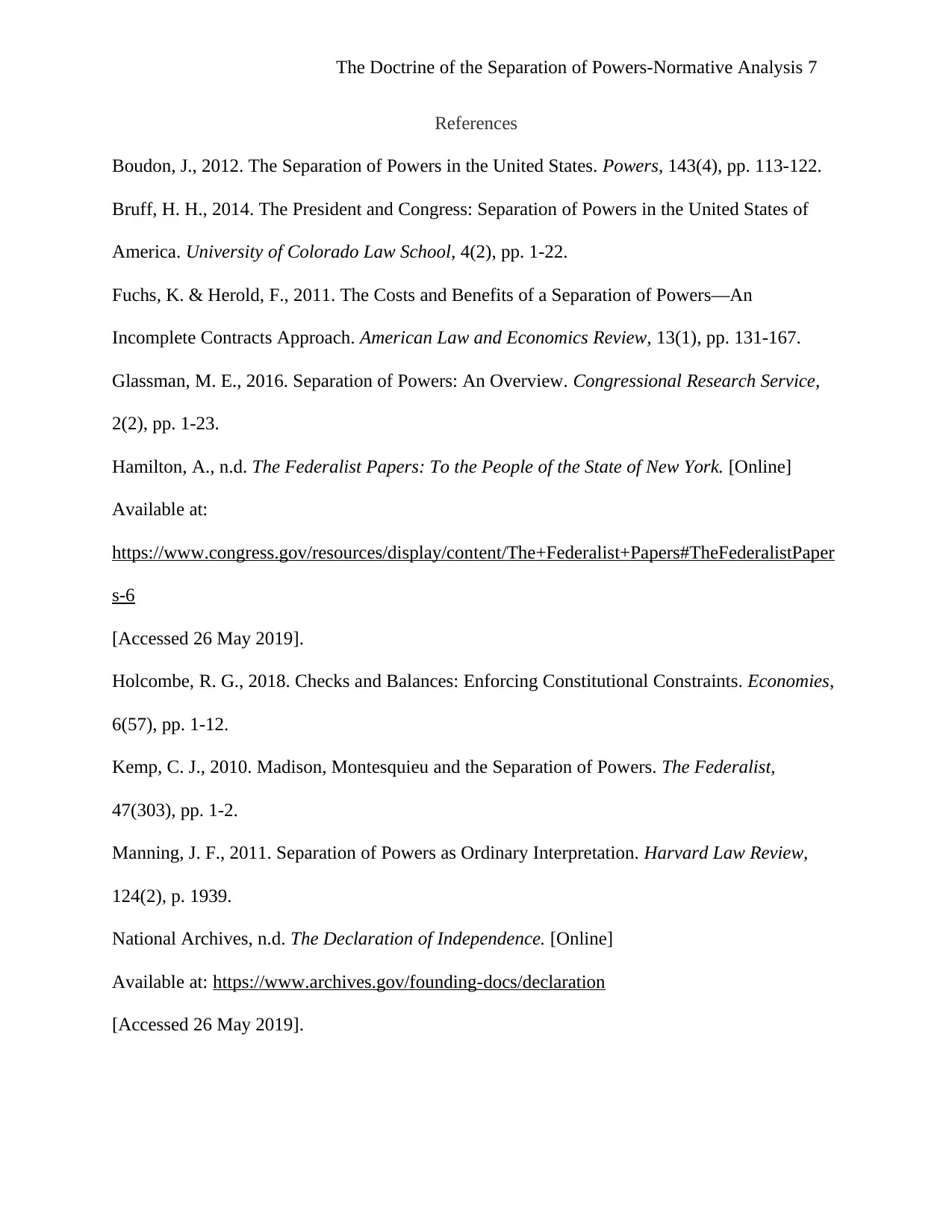
The Doctrine of the Separation of Powers-Normative Analysis 7
References
Boudon, J., 2012. The Separation of Powers in the United States. Powers, 143(4), pp. 113-122.
Bruff, H. H., 2014. The President and Congress: Separation of Powers in the United States of
America. University of Colorado Law School, 4(2), pp. 1-22.
Fuchs, K. & Herold, F., 2011. The Costs and Benefits of a Separation of Powers—An
Incomplete Contracts Approach. American Law and Economics Review, 13(1), pp. 131-167.
Glassman, M. E., 2016. Separation of Powers: An Overview. Congressional Research Service,
2(2), pp. 1-23.
Hamilton, A., n.d. The Federalist Papers: To the People of the State of New York. [Online]
Available at:
https://www.congress.gov/resources/display/content/The+Federalist+Papers#TheFederalistPaper
s-6
[Accessed 26 May 2019].
Holcombe, R. G., 2018. Checks and Balances: Enforcing Constitutional Constraints. Economies,
6(57), pp. 1-12.
Kemp, C. J., 2010. Madison, Montesquieu and the Separation of Powers. The Federalist,
47(303), pp. 1-2.
Manning, J. F., 2011. Separation of Powers as Ordinary Interpretation. Harvard Law Review,
124(2), p. 1939.
National Archives, n.d. The Declaration of Independence. [Online]
Available at: https://www.archives.gov/founding-docs/declaration
[Accessed 26 May 2019].
References
Boudon, J., 2012. The Separation of Powers in the United States. Powers, 143(4), pp. 113-122.
Bruff, H. H., 2014. The President and Congress: Separation of Powers in the United States of
America. University of Colorado Law School, 4(2), pp. 1-22.
Fuchs, K. & Herold, F., 2011. The Costs and Benefits of a Separation of Powers—An
Incomplete Contracts Approach. American Law and Economics Review, 13(1), pp. 131-167.
Glassman, M. E., 2016. Separation of Powers: An Overview. Congressional Research Service,
2(2), pp. 1-23.
Hamilton, A., n.d. The Federalist Papers: To the People of the State of New York. [Online]
Available at:
https://www.congress.gov/resources/display/content/The+Federalist+Papers#TheFederalistPaper
s-6
[Accessed 26 May 2019].
Holcombe, R. G., 2018. Checks and Balances: Enforcing Constitutional Constraints. Economies,
6(57), pp. 1-12.
Kemp, C. J., 2010. Madison, Montesquieu and the Separation of Powers. The Federalist,
47(303), pp. 1-2.
Manning, J. F., 2011. Separation of Powers as Ordinary Interpretation. Harvard Law Review,
124(2), p. 1939.
National Archives, n.d. The Declaration of Independence. [Online]
Available at: https://www.archives.gov/founding-docs/declaration
[Accessed 26 May 2019].
Paraphrase This Document
Need a fresh take? Get an instant paraphrase of this document with our AI Paraphraser
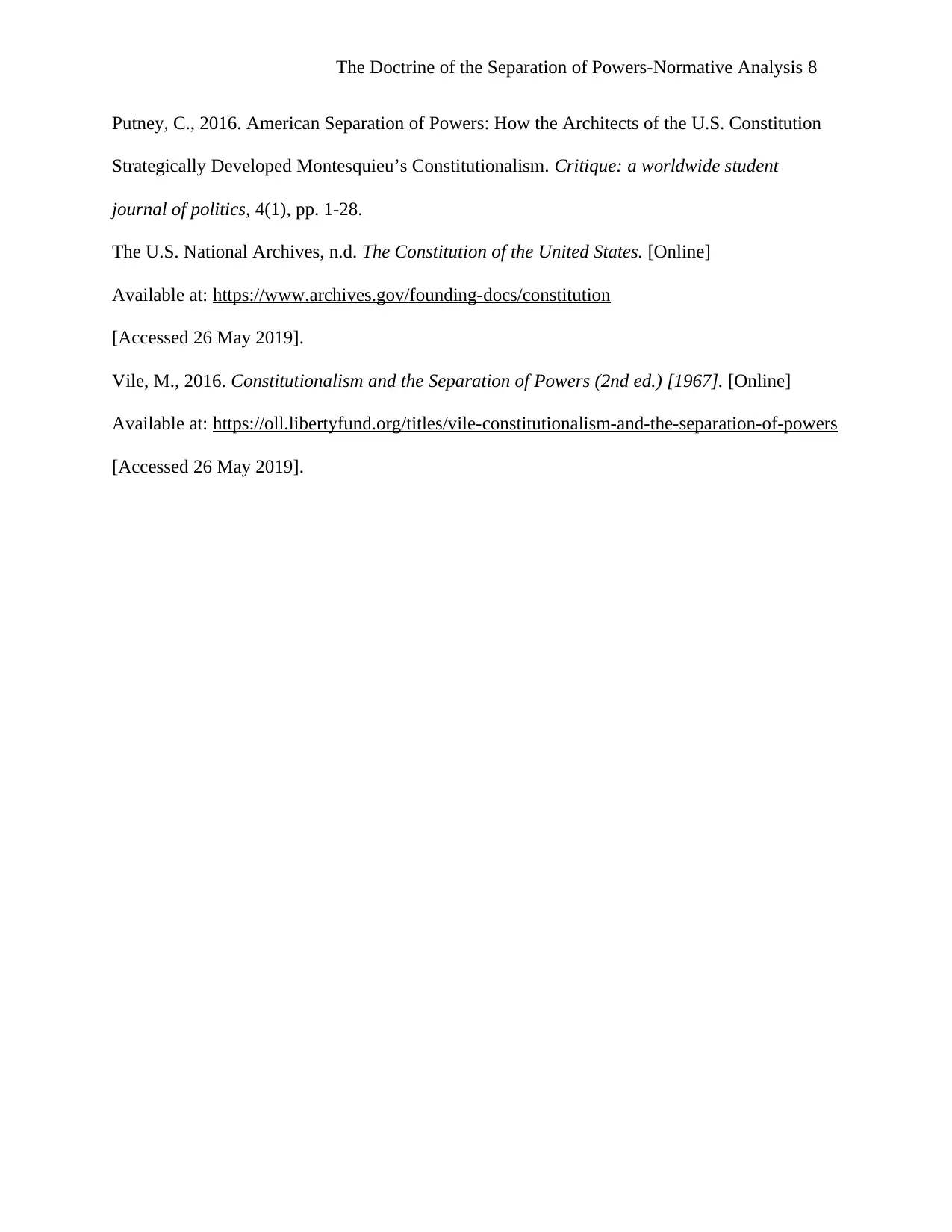
The Doctrine of the Separation of Powers-Normative Analysis 8
Putney, C., 2016. American Separation of Powers: How the Architects of the U.S. Constitution
Strategically Developed Montesquieu’s Constitutionalism. Critique: a worldwide student
journal of politics, 4(1), pp. 1-28.
The U.S. National Archives, n.d. The Constitution of the United States. [Online]
Available at: https://www.archives.gov/founding-docs/constitution
[Accessed 26 May 2019].
Vile, M., 2016. Constitutionalism and the Separation of Powers (2nd ed.) [1967]. [Online]
Available at: https://oll.libertyfund.org/titles/vile-constitutionalism-and-the-separation-of-powers
[Accessed 26 May 2019].
Putney, C., 2016. American Separation of Powers: How the Architects of the U.S. Constitution
Strategically Developed Montesquieu’s Constitutionalism. Critique: a worldwide student
journal of politics, 4(1), pp. 1-28.
The U.S. National Archives, n.d. The Constitution of the United States. [Online]
Available at: https://www.archives.gov/founding-docs/constitution
[Accessed 26 May 2019].
Vile, M., 2016. Constitutionalism and the Separation of Powers (2nd ed.) [1967]. [Online]
Available at: https://oll.libertyfund.org/titles/vile-constitutionalism-and-the-separation-of-powers
[Accessed 26 May 2019].
1 out of 8
Related Documents
Your All-in-One AI-Powered Toolkit for Academic Success.
+13062052269
info@desklib.com
Available 24*7 on WhatsApp / Email
![[object Object]](/_next/static/media/star-bottom.7253800d.svg)
Unlock your academic potential
© 2024 | Zucol Services PVT LTD | All rights reserved.





